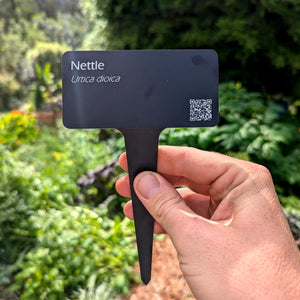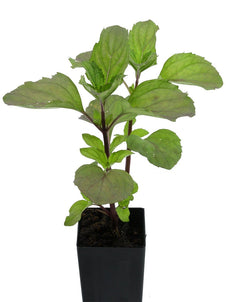
Mint - Eau de Cologne Mint
Mint - Eau de Cologne Mint

- In stock, ready to ship
- Inventory on the way

Usually available: All year
Life cycle: Perennial
Height: 30 - 45cm
Position: Sun / part shade
Soil preference: Moist / well drained
This is how we pack and send your Herb Plants to all states except TAS & WA
You will receive
- 1 Eau de Cologne Mint Herb Plant in a 50 X 75mm tube - General growing instructions
All of our Herb Plants are grown organically with certified organic potting mixes and fertilizers
Botanical Name: Mentha citrata
Eau de Cologne Mint is a low growing perennial with an erect growth habit. It reaches up to 30-45 cm high and spreads up to 1 meter. The smooth oval leaves are green, but the serrated leaf edges are often tinged with bronze or purple. The lemon-like perfume or aroma is strong and quite sharply intense. It is considered one of the most fragrant of all the mints. Even softly crushing the leaves will release the aroma. The lilac flowers appear from mid to late summer and may continue through to autumn.
Eau de Cologne mint is sometimes called Lemon Mint. It is a natural hybrid of the natural M. aquatica (Water Mint) and M. spicata (Spearmint), with the botanical name Mentha x piperita var citrata. Another common mint, Peppermint, is also a natural hybrid from this pairing and is named Mentha x piperita var piperita. Eau de Cologne Mint may also go by many common or alternative names including Horse Mint, Lime Mint, Lemon Mint, Bergamot Mint, Orange Mint and Wild Water Mint.
Although the manufactured Eau de Cologne is now produced synthetically, this mint was the original source of the fragrance.
Mint General
There are many Mint varieties known to herb gardeners and lovers of good cuisine, all varying slightly in flavour, aroma and appearance. They are categorized in the genus ‘Mentha’, which has up to 18 species, within the Lamiaceae family of plants. The Lamiaceae family is known as the mint family. However, the largest group of plants in the mint family is actually the delightful Salvias with their brilliantly coloured blooms. Many other commonly known herbs are also found in this family, including basil, sage, thyme and even lavender. One characteristic of this plant family is that they all yield essential oils, giving each plant its unique characteristics and even potential for medicinal use. Even the Scutellaria genus, with the unusually named Baikal Skullcap is found within this family.
The mints consist of mostly spreading and low growing perennial plants. The height range is from 10 cm to 1 meter, so not all are at ground level. Mint plants send out runners, or stolons, to help them spread by developing roots and shoots at the nodes. This allows plants to cover up to 1 meter in stem growth, in good conditions. They are all fast growing plants and due to the spreading nature, one plant is often sufficient for most gardeners. Some mints can be invasive and it is recommended that containers or in ground barriers be used. Mints can suffer from some pests like snails and aphids and may be affected by mint rust. Rust Free Mint may also be a useful addition to the garden in addition to the many other varieties.
Most mint plants have square stems, with leaves held in opposite pairs. They are often downy with a serrated margin, with a variable leaf shape and colours ranging from green to purple. The flowers are usually white to purple and present in false whorls or verticillaster or false whorl. The corolla is usually two lipped and has 4 lobes, with the upper lobe usually the largest.
Mint plants come from across the globe and will grow in most climates, including a wide range of regions across Australia. Some are annual varieties, but in cool climate zones perennial mints may best be treated as annuals and replaced each year. Generally they have high water requirements and prefer rich soils. Mint is grown commercially in Tasmania due to the ideal conditions of long summer days in high altitudes, where temperatures average 25C during the day to 15C at night. Ideal conditions usually require full sun, but part shade may be necessary as temperatures increase in warm summer regions.
Most mints have a history of traditional medicinal or herbal use for fevers, headaches and minor ailments. These plants are often used as a digestive aid in the form or herbal tea. The essential oil is also antiseptic and may be toxic in very high doses. They should be avoided by pregnant women and must not be given, or placed next to the face of babies and young children, due to the potential for breathing difficulties associated with menthol.
Mint hybridizes very easily, so there are many varieties available to suit any garden. In fact, if you have mixed plants some may hybridize in your own garden. The most popular choices are Spearmint, Peppermint and Applemint. However, many varieties in our collection, such as Ginger Mint, Eau de Cologne, Chocolate Mint and many others are also becoming well known.
Growing Conditions
Eau de Cologne Mint tolerates part shade and low light, but a full sun position is best to increase the essential oil content in the leaves. This mint will tolerate a range of soil types including clay soils, although the soil should ideally have an open texture and be slightly acidic. The soil should be moist and not allowed to dry out for long periods, with extra water in summer to prevent wilting.
This decorative herb will tolerate neglect and is quite hardy. If the plants start to become lanky, they may be cut back and new growth will fill out the plant again. Like many mints Eau de Cologne may ‘run away’ due to spreading roots systems, so container growing may solve this problem. Propagation may be carried out by division.
Culinary Uses
The true Eau de Cologne Mint is pungent and often too strong for most palates. However there are many cultivars that and some are more palatable. When used to garnish fruit salad, for desserts, cheesecakes and cold drinks the leaves add a nice lemon aroma and taste. The leaves may be harvested at any time.
Medicinal Uses
The Eau de Cologne Mint differs from other mints and has similar medicinal properties to the Lavender group of plants. The essential oil from the plant can be used to create lavender oil. Traditional medicine uses include its beneficial effect on digestion, use as an antiseptic, and as an herbal tea remedy for headaches and general ailments. A few crushed leaves taken from the garden and rubbed on the forehead will ease a mild headache. It is also anti-spasmodic, carminative, cholagogic, diaphoretic, and has vasodilation properties.
Pregnant women should avoid the essential oils in this mint due to the risk of uterine spasms and miscarriage.
Other Uses
Eau de Cologne Mint is reputed to be a good insect repellent and is used by crushing some leaves and rubbing over arms and legs as needed when outdoors. It is also said to be one of the best refreshing bath mints. The best way to scent a bath is to collect a bunch of leaves and put them into a muslin bag, tie in a handkerchief or use an old sock and hang it near the tap water as it runs into the bath. Then let the bag sit in the water or allow leaves to float in the bath.
All information provided on this website is for informational purposes only. Please seek professional advice before commencing any treatment.




